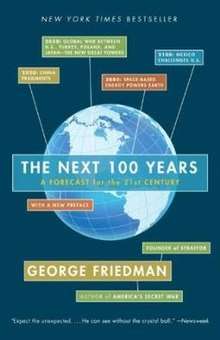The Next 100 Years: A Forecast for the 21st Century
 | |
| Author | George Friedman |
|---|---|
| Country | United States |
| Language | English |
Publication date | 2009 |
| Media type | |
| ISBN | 0-385-51705-X |
The Next 100 Years: A Forecast for the 21st Century is a 2009 book by George Friedman. In the book, Friedman attempts to predict the major geopolitical events and trends of the 21st century. Friedman also speculates in the book on changes in technology and culture that may take place during this period.
Overview
Friedman predicts overall historical trends for the 21st century, such as that the United States will remain the dominant global superpower throughout the 21st century, and that the history of the 21st century will consist mainly of attempts by other world powers to challenge American dominance. Although mainly about the geopolitics of the century, the book also makes some economic, social, and technological predictions for the 21st century.
Friedman also presents specific examples of what might happen, stressing that these are only possible scenarios intended to illustrate the overall trends and issues of the century. Among these are a second period of confrontation between Western powers and Russia, with the West emerging triumphant and a rise of a powerful Poland allied to the United States. Another scenario presented for later in the century is a Third World War between the United States, the "Polish Bloc", Britain, India, and China on one side, and Turkey and Japan on the other, with Germany and France entering the war in its late stages on the side of Turkey and Japan. Space power is presented as playing a critical role in this war, with the war's outcome resulting in American dominance in controlling access to space for decades.
Other trends predicted include significant immigration flows, with the American ability to successfully assimilate immigrants being a source of U.S. strength through the century. However, by the end of the 21st century, Friedman predicts that the cultural and political differences between the Hispanic-dominated American Southwest and the rest of the country will cause a national crisis.
In 2015, Stratfor published a decade forecast for 2015-2025, which revised the predictions made in the book on Russia and China. Rather than the Russian government completely collapsing, it envisioned that the Russian government would lose much of its power, and the country would gradually fragment into a series of semi-autonomous regions. In addition, while the book had postulated that Chinese fragmentation was more likely than the re-imposition of authoritarian rule, the analysis predicted that regional fragmentation was now a less-likely scenario for China, with the most probable result being the re-imposition of strict authoritarian rule.
Reception
The Next 100 Years reached #5 on the New York Times non-fiction best seller list.[1]
The San Francisco Chronicle criticized the book's U.S.-centrism and military emphasis: "Friedman's strangely provincial stance resembles some frightened insomniac who can't stop playing Age of Empires because he desperately needs to win before dawn."[2]
Film adaptation
A film inspired by the book is in production: directed by Sam Raimi and called World War 3.[3]
References
- ↑ "Best Sellers NonFiction". New York Times. 15 February 2009. Retrieved 10 March 2017.
- ↑ Champion, Edward (17 February 2009). "Nonfiction review: 'The Next 100 Years'". San Francisco Chronicle. Retrieved 10 March 2017.
- ↑ Trumbore, Dave (26 February 2016). "Sam Raimi to Predict a Terrible Future in 'World War 3' for Warner Bros". Collider. Retrieved 10 March 2017.